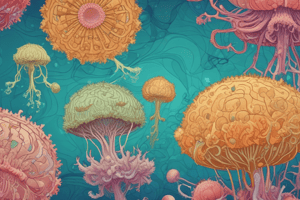Podcast
Questions and Answers
What is the primary component of the test of diatoms?
What is the primary component of the test of diatoms?
- Silica (correct)
- Calcium carbonate
- Cellulose
- Chitin
Which of the following statements is true regarding the Euglena genus?
Which of the following statements is true regarding the Euglena genus?
- They exclusively feed by absorption.
- They can photosynthesize and capture their own food. (correct)
- They are characterized by a rigid cell wall.
- They possess only one type of flagellum.
What aids in light detection in Euglena organisms?
What aids in light detection in Euglena organisms?
- Red stigma (eyespot) (correct)
- Chloroplasts
- Mitochondria
- Paramylon body
How many genera of euglenozoans have been described?
How many genera of euglenozoans have been described?
What is the function of the pellicle in Euglena?
What is the function of the pellicle in Euglena?
Which group do choanoflagellates belong to?
Which group do choanoflagellates belong to?
What unique feature do choanoflagellates possess?
What unique feature do choanoflagellates possess?
Which of the following phyla includes diatoms?
Which of the following phyla includes diatoms?
What is a characteristic of green algae (Phylum Chlorophyta)?
What is a characteristic of green algae (Phylum Chlorophyta)?
Which of the following statements about algae is incorrect?
Which of the following statements about algae is incorrect?
Which type of algae is most numerous in marine and freshwater environments?
Which type of algae is most numerous in marine and freshwater environments?
What do green algae and modern plants have in common?
What do green algae and modern plants have in common?
Where can some species of green algae be found growing?
Where can some species of green algae be found growing?
Flashcards
Diatoms
Diatoms
Microscopic algae with intricate, geometric shapes. Their cell walls are made of silica, similar to glass.
Diatomaceous Earth
Diatomaceous Earth
A natural deposit of fossilized diatoms. It's used in various products like silverware polish, insulation, and toothpaste.
Euglenophyta
Euglenophyta
A group of algae with about 1000 species, mostly freshwater. They are known for having flagella for movement.
Pellicle
Pellicle
Signup and view all the flashcards
Euglena
Euglena
Signup and view all the flashcards
Choanoflagellates
Choanoflagellates
Signup and view all the flashcards
Opisthokonta
Opisthokonta
Signup and view all the flashcards
Algae
Algae
Signup and view all the flashcards
Chlorophyll a
Chlorophyll a
Signup and view all the flashcards
Green Algae (Chlorophyta)
Green Algae (Chlorophyta)
Signup and view all the flashcards
Diatoms (Bacillariophyta)
Diatoms (Bacillariophyta)
Signup and view all the flashcards
Test
Test
Signup and view all the flashcards
Archaeplastida
Archaeplastida
Signup and view all the flashcards
Study Notes
Choanoflagellates
- Choanoflagellates are protists, possibly ancestral to fungi and animals.
- They exist as single cells or in colonies in freshwater and marine environments.
- Their structure resembles collar cells in sponges - a single flagellum surrounded by a collar of cytoplasmic extensions (tentacles).
- They are part of the Opisthokonta supergroup, which includes fungi and animals.
Algae
- Algae are diverse photoautotrophic protists, ranging from microscopic diatoms to large kelp.
- They contain chlorophyll a and plastids, producing oxygen and forming the base of food chains.
- Traditionally, algal phyla are categorized by accessory pigments; examples of phyla studied are Chlorophyta, Rhodophyta, Bacillariophyta (diatoms), and Euglenophyta.
Green Algae (Chlorophyta)
- Chlorophyta (green algae) are in the Archaeplastida group, comprising about 10,000 unicellular and multicellular species.
- Mostly aquatic, some live on various surfaces (tree trunks, etc) and even on sloths.
- Considered ancestors of modern plants.
Diatoms (Bacillariophyta)
- Diatoms are uniquely shaped, single-celled algae in the Stramenopiles group.
- Possess a silica shell (test) composed of two halves.
- Abundant in marine and freshwater environments, with estimated species ranging from 10,000 to a million.
- Silica-based shells make them common in the fossil record; diatomaceous earth is a significant deposit used in various products.
Euglenophyta
- Euglenophyta (euglenoids) are single-celled, flagellated freshwater organisms in the Excavata group.
- Approximately 1,000 species, roughly half are photosynthetic, and half are non-photosynthetic.
- Non-photosynthetic species feed by particle ingestion and absorption.
- Photosynthetic euglenoids (e.g., Euglena) are characterized by chloroplasts, a pellicle (helical protein bands), and visible flagella for movement, a paramylon body, a gullet, and a red eyespot.
Studying That Suits You
Use AI to generate personalized quizzes and flashcards to suit your learning preferences.




